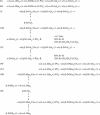Streptococcus pneumoniae Capsular Polysaccharide - PubMed (original) (raw)
Review
Streptococcus pneumoniae Capsular Polysaccharide
James C Paton et al. Microbiol Spectr. 2019 Mar.
Abstract
The polysaccharide capsule of Streptococcus pneumoniae is the dominant surface structure of the organism and plays a critical role in virulence, principally by interfering with host opsonophagocytic clearance mechanisms. The capsule is the target of current pneumococcal vaccines, but there are 98 currently recognised polysaccharide serotypes and protection is strictly serotype-specific. Widespread use of these vaccines is driving changes in serotype prevalence in both carriage and disease. This chapter summarises current knowledge on the role of the capsule and its regulation in pathogenesis, the mechanisms of capsule synthesis, the genetic basis for serotype differences, and provides insights into how so many structurally distinct capsular serotypes have evolved. Such knowledge will inform ongoing refinement of pneumococcal vaccination strategies.
Figures
FIGURE 1
Comparison of the CPS biological repeat unit structures of S. pneumoniae serotypes 6A, 6B, 14, 15B, 15C 19F, 19A, 19B, and 19C. These are based on published chemical repeat unit structures (9), adjusting for the fact that Glc is the first sugar of the biological repeat unit.
FIGURE 2
Organization of the cps loci from selected S. pneumoniae serotypes. Gene and locus designations are as published. Open reading frames (ORFs) within the DNA sequence are indicated by large boxed arrows. Highly conserved ORFs, or those encoding proteins belonging to a particular functional group, are identified as shown in the legend at the bottom of the figure. Assignment of an ORF to a given function-related group is based on the published information for each locus as well as on additional database comparisons for some of the ORFs. The short boxed arrows represent cryptic ORFs not required for CPS biosynthesis in the respective serotype.
Similar articles
- Depressing time: Waiting, melancholia, and the psychoanalytic practice of care.
Salisbury L, Baraitser L. Salisbury L, et al. In: Kirtsoglou E, Simpson B, editors. The Time of Anthropology: Studies of Contemporary Chronopolitics. Abingdon: Routledge; 2020. Chapter 5. In: Kirtsoglou E, Simpson B, editors. The Time of Anthropology: Studies of Contemporary Chronopolitics. Abingdon: Routledge; 2020. Chapter 5. PMID: 36137063 Free Books & Documents. Review. - Qualitative evidence synthesis informing our understanding of people's perceptions and experiences of targeted digital communication.
Ryan R, Hill S. Ryan R, et al. Cochrane Database Syst Rev. 2019 Oct 23;10(10):ED000141. doi: 10.1002/14651858.ED000141. Cochrane Database Syst Rev. 2019. PMID: 31643081 Free PMC article. - Intra-serotype variation of Streptococcus pneumoniae capsule and its quantification.
Eichner H, Wu C, Cammer M, Tran ENH, Hirst TR, Paton JC, Weiser JN. Eichner H, et al. Microbiol Spectr. 2025 Apr;13(4):e0308724. doi: 10.1128/spectrum.03087-24. Epub 2025 Feb 14. Microbiol Spectr. 2025. PMID: 39950804 Free PMC article. - Ceftazidime with avibactam for treating severe aerobic Gram-negative bacterial infections: technology evaluation to inform a novel subscription-style payment model.
Harnan S, Kearns B, Scope A, Schmitt L, Jankovic D, Hamilton J, Srivastava T, Hill H, Ku CC, Ren S, Rothery C, Bojke L, Sculpher M, Woods B. Harnan S, et al. Health Technol Assess. 2024 Oct;28(73):1-230. doi: 10.3310/YAPL9347. Health Technol Assess. 2024. PMID: 39487661 Free PMC article. - Valley fever under a changing climate in the United States.
Howard MH, Sayes CM, Giesy JP, Li Y. Howard MH, et al. Environ Int. 2024 Nov;193:109066. doi: 10.1016/j.envint.2024.109066. Epub 2024 Oct 11. Environ Int. 2024. PMID: 39432997 Review.
Cited by
- Comparative genome analysis unravels pathogenicity of Xanthomonas albilineans causing sugarcane leaf scald disease.
Li M, Bao Y, Li Y, Akbar S, Wu G, Du J, Wen R, Chen B, Zhang M. Li M, et al. BMC Genomics. 2022 Sep 26;23(1):671. doi: 10.1186/s12864-022-08900-2. BMC Genomics. 2022. PMID: 36162999 Free PMC article. - Unraveling Capsule Biosynthesis and Signaling Networks in Cryptococcus neoformans.
Jang EH, Kim JS, Yu SR, Bahn YS. Jang EH, et al. Microbiol Spectr. 2022 Dec 21;10(6):e0286622. doi: 10.1128/spectrum.02866-22. Epub 2022 Oct 26. Microbiol Spectr. 2022. PMID: 36287085 Free PMC article. - Genomic Epidemiology of Streptococcus pneumoniae Isolated in a Tertiary Hospital in Beijing, China, from 2018 to 2022.
Fan S, Duan N, Chen W, Zhao X, Wang L, Du P, Guo J. Fan S, et al. Pathogens. 2023 Feb 9;12(2):284. doi: 10.3390/pathogens12020284. Pathogens. 2023. PMID: 36839557 Free PMC article. - Glycan-mediated molecular interactions in bacterial pathogenesis.
Lee S, Inzerillo S, Lee GY, Bosire EM, Mahato SK, Song J. Lee S, et al. Trends Microbiol. 2022 Mar;30(3):254-267. doi: 10.1016/j.tim.2021.06.011. Epub 2021 Jul 14. Trends Microbiol. 2022. PMID: 34274195 Free PMC article. Review. - Bacterial capsules: Occurrence, mechanism, and function.
Gao S, Jin W, Quan Y, Li Y, Shen Y, Yuan S, Yi L, Wang Y, Wang Y. Gao S, et al. NPJ Biofilms Microbiomes. 2024 Mar 13;10(1):21. doi: 10.1038/s41522-024-00497-6. NPJ Biofilms Microbiomes. 2024. PMID: 38480745 Free PMC article. Review.
References
Publication types
MeSH terms
Substances
LinkOut - more resources
Full Text Sources

